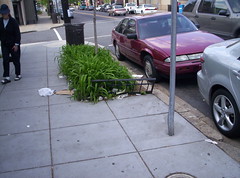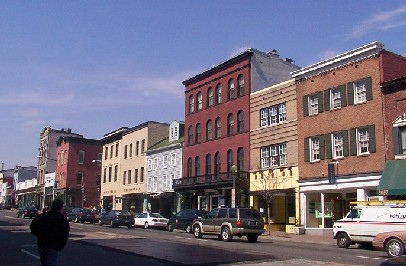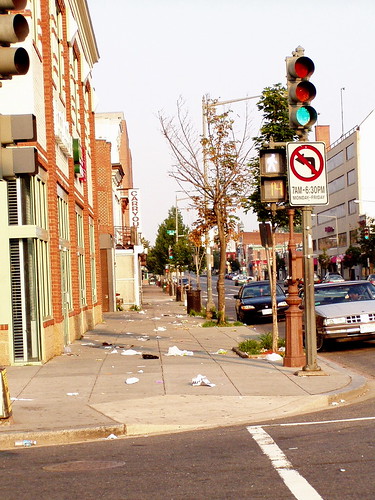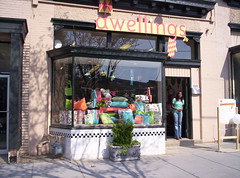The "soft side" of commercial district competition
Late Friday, I wrote some email on the Main Street list in response to a query about cleaning services in neighborhood commercial districts. The following is a cobbling together of three emails...
When is the last time you went to a dirty, filthy shopping mall? Why do Main Street merchants believe that the expectations of the customers are any different when they are considering shopping in neighborhood or downtown commercial districts?
I am a firm believer in Donald Shoup's (professor at UCLA) statement that public help should go to those who've already begun helping themselves. I know that Main Street merchants aren't the ones dirtying their street, but why are they so cavalier about the impact of unkempt sidewalks upon their ability to attract customers?
I do understand why merchants think that way--they are not the ones dirtying the streets. The disconnect concerns the perceptions that customers and potential customers have about the commercial district and the businesses located there, as well as the condition of the area around the business. People dirty the streets around the merchants' businesses, and if the problems aren't corrected, other people's carelessness costs the merchants money...
Right now, people in the neighborhood are talking about this particular restaurant and how great the new owner is, etc., but that ignores the condition of the exterior of the building.
Few people are going to patronize the business except as a reflection of "community support" or having no other options. (The issue is to work to get the facade improved... not to discourage the business from improving, but in the current condition this business is unlikely to generate "catalytic" improvement benefits that contribute to the commercial district as a whole.)

Ohio Restaurant, 1300 block H Street NE, Washington, DC. Photo by Elise Bernard.
This is why I talk about "soft aspects" in relation to the Reilly Law of Retail Gravitation:
(1) the quality and condition of the buildings;
(2) the cleanliness of the street and sidewalks;
(3) the condition of the street furniture, treeboxes and other aspects of the physical environment;
(4) the signage and windows of the businesses;
(5) the quality and organization of the store interiors.
Each influences whether or not people will choose to shop in your commercial district, or if they will merely continue to shop elsewhere because you provide no compelling reason for them to change their minds, attitudes, habits, and comfortability.
These factors plus the number and quality of stores and the issue of how to get there are the primary considerations influencing people's decisions about where to shop, eat, or play...
People compare our neighborhood and downtown commercial districts to shopping centers or to the best-in-class traditional commercial districts in your region. So to be equally competitive, we have to do many of the same things the shopping centers do, and primary is providing a clean environment.

3500 block west side, 12th Street NE, Brookland. Recognize that I already had picked up a fair amount of trash from this sidewalk on my way to the drug store, before I came back with my camera.

Treebox, Brookland commercial district.
In the DC region, the best-in-class independent commercial district is Georgetown. Where do you think people would rather shop?

In Georgetown. Photo (resized), by Dan Malouff.

or on H Street NE? (Photo by Elise Bernard)

Dwellings, Brookland Commercial District, 12th Street NE.
I think Brookland has potential, but it needs more businesses that look like this--bright, cheery, with quality and interesting products, helpful staff, and a building in good condition. Fortunately, it has many business proprietors who do understand the direction that the commercial district needs to move toward.
On Saturday, It occurred to me that the best way that Brookland can make a case for commercial district cleaning services is to do a litter survey (a la Keep America Beautiful), at different times of the day, to begin to develop a priority list and a strong case for funding additional services:
-- identify which areas are consistently dirty;
-- which areas need regular cleaning but less often
-- we can do X with such and such amount
-- and X + Y with additional resources
etc. This data can be used with merchants, as well as perhaps creating a kind of "Visual Preference Survey" showing them other commercial districts that their customers might patronize. And how they compare.
This is why I joke about Main Street principles #9 and #10 (there are officially only 8 principles)--knowing what you have (or not) and being honest about it; and making the hard choices you need to make in order to improve.
As long as a particular urban commercial district is deficient compared to nearby shopping alternatives, it won't be able to attract new customers, until it starts providing some decent options. You can put any kind of sugar coating on it that you want, but it's these factors that must be addressed:
(1) the quality and condition of the buildings;
(2) the cleanliness of the street and sidewalks;
(3) the condition of the street furniture, treeboxes and other aspects of the physical environment;
(4) the signage and windows of the businesses; and
(5) the quality and organization of the store interiors.
This is important enough to be repeated...
Until you do so, your commercial district will languish because as long as your commercial district suffers on perception indicators, you will continue to have difficulties filling your vacancies and attracting higher quality and a greater variety of businesses.
Labels: commercial district revitalization, retail



1 Comments:
This is a great post.
This post shares information about commercial district.
Visit here-"usa online pharmacy"
Post a Comment
<< Home